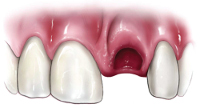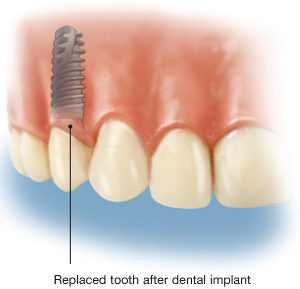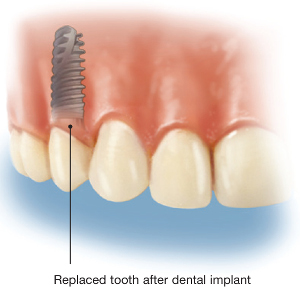Root canal treatment, retreatment or endodontic surgery may all be ways to help you save your tooth. Sometimes, however, a tooth cannot be saved, and will need to be extracted and replaced with a prosthetic, or artificial, tooth. You should talk to an endodontist about all of your options to save your natural tooth before choosing to have a tooth extracted.
What are the alternatives to endodontic treatment?
Though endodontic procedures are intended to help save your tooth, this is not always possible. Often, the only alternative to endodontic treatment is extraction of the tooth. Missing teeth can make you self-conscious, affect your ability to bite and chew, cause other healthy teeth to shift and have a negative impact on your overall health. For these reasons, the extracted tooth should be replaced with an artificial one.
What is a dental implant?
 Implants are a state-of-the-art replacement for missing teeth. A dental implant is an artificial tooth root placed into your jaw to hold a replacement tooth – the crown - in place. The implant emulates the shape of the root and is usually made of titanium and other materials that are well-suited to the human body. The implant is surgically placed into the jaw and incorporates into the bone over time to become a stable base for crowns. Dental implants have been used for several decades by patients of all ages. They can replace a single tooth, several teeth or support partial or full dentures.
Implants are a state-of-the-art replacement for missing teeth. A dental implant is an artificial tooth root placed into your jaw to hold a replacement tooth – the crown - in place. The implant emulates the shape of the root and is usually made of titanium and other materials that are well-suited to the human body. The implant is surgically placed into the jaw and incorporates into the bone over time to become a stable base for crowns. Dental implants have been used for several decades by patients of all ages. They can replace a single tooth, several teeth or support partial or full dentures.
What’s involved in placing an implant?
 The way implants are placed depends on the patient, the type of implant and the tooth being replaced. Some implants can be fully placed in one day. Most implants involve two or three steps. First, the implant is placed into the jaw and the gum is secured over the implant. Over the next three to six months the implant will fuse with the jaw bone. Once the implant and bone have bonded together, the dentist or specialist may attach an extension, called an abutment, to the implant. In some cases, the implant and abutment are a single unit placed during the initial surgery. In others, a second surgery may be needed to attach the abutment to the replacement teeth. Once healed, the implant and abutment act as the foundation for the new tooth. In the final step, the dentist or specialist makes a crown in the right size, shape and color to match your natural teeth. The crown is attached to the implant post.
The way implants are placed depends on the patient, the type of implant and the tooth being replaced. Some implants can be fully placed in one day. Most implants involve two or three steps. First, the implant is placed into the jaw and the gum is secured over the implant. Over the next three to six months the implant will fuse with the jaw bone. Once the implant and bone have bonded together, the dentist or specialist may attach an extension, called an abutment, to the implant. In some cases, the implant and abutment are a single unit placed during the initial surgery. In others, a second surgery may be needed to attach the abutment to the replacement teeth. Once healed, the implant and abutment act as the foundation for the new tooth. In the final step, the dentist or specialist makes a crown in the right size, shape and color to match your natural teeth. The crown is attached to the implant post.
 Dental implants provide a good alternative for the natural tooth when it must be extracted. Candidates for implants should have good general and oral health, adequate bone support in the jaw and healthy gum tissues. Chronic illnesses, such as diabetes or leukemia, may interfere with healing after surgery and prevent successful placement of an implant. Other risk factors for implant placement can include smoking, poor bone quality, long-term use of bisphosphonate medications, and low estrogen levels.
Dental implants provide a good alternative for the natural tooth when it must be extracted. Candidates for implants should have good general and oral health, adequate bone support in the jaw and healthy gum tissues. Chronic illnesses, such as diabetes or leukemia, may interfere with healing after surgery and prevent successful placement of an implant. Other risk factors for implant placement can include smoking, poor bone quality, long-term use of bisphosphonate medications, and low estrogen levels.
Replacing a missing or diseased tooth with an implant has several advantages:
- Natural appearance
- Don’t require dental procedures on neighboring teeth
- Reliable
Though nothing looks, feels or functions exactly like your natural tooth, dental implants are a viable alternative to help you maintain a beautiful smile.
Are there any other options?
For replacement of an extracted tooth, you may also consider a bridge or removable partial denture. These options require additional dental procedures on adjacent healthy teeth, and should be discussed with your dentist or specialist.
Who performs the procedures?
All dentists, including your general dentist, received training in endodontic treatment and dental implants in dental school. General dentists can perform these procedures, but often they refer patients with diseased teeth to endodontists for evaluation and treatment.
Endodontists are dentists with special training in endodontic procedures. They focus on endodontics in their practices because they are specialists. To become specialists, they complete dental school and an additional two or more years of advanced training in endodontics. They perform routine as well as difficult and very complex endodontic procedures, including endodontic surgery. Many endodontists have also received additional training in the placement of dental implants, and can perform this procedure for patients whose teeth cannot be saved.
Your dentist may have referred you to an endodontic specialist because of a personal concern about your medical conditions, treatment preferences, pain tolerance and/or the overall high quality of your dental care. The endodontist is a valuable partner on your general dentist’s team of trusted caregivers, and is no different than medical specialists who provide expert advice for heart, bone or other health problems. Endodontists are uniquely qualified to evaluate whether your tooth can be saved, and which option is best for you.
How do I make a choice?
Research has proven that endodontic treatment and dental implants are equally successful. Therefore, it makes sense to start by trying to save your natural tooth – nothing looks, feels or functions like it. If, for whatever reason, healing does not occur, then treatment with a dental implant is an excellent backup plan.
Ultimately, your treatment decision should be based on a strategy you have discussed with your dental team (your dentist, endodontist and/or other specialists), and that you agree is best for your overall health.
Original Article Here.
Reprinted with permission of the AAE. Copyright © 2017 American Association of Endodontists. All Rights Reserved.
